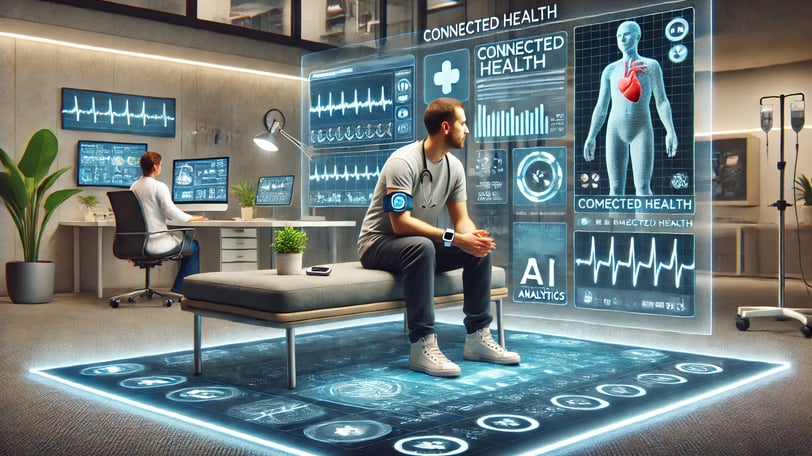Connected Health: Remote Patient Monitoring and Telemedicine in the United States
The healthcare industry is undergoing a technological revolution, driven by the increasing adoption of Connected Health solutions. Remote patient monitoring (RPM) and telemedicine are transforming how medical care is delivered, providing real-time data, improving accessibility, and reducing hospital admissions. With the expansion of digital health tools, artificial intelligence, and wearable medical devices, the United States is at the forefront of this transformatio
3/7/20253 min read


The Evolution of Connected Health
Connected Health encompasses a range of digital technologies designed to enhance patient care outside traditional healthcare facilities. This includes:
Remote Patient Monitoring (RPM): The use of smart devices to collect patient data, such as heart rate, blood pressure, and glucose levels, transmitting it to healthcare providers in real time.
Telemedicine: Virtual consultations between patients and healthcare professionals via video calls, messaging, or mobile apps.
Artificial Intelligence (AI) in Healthcare: AI-driven diagnostics, predictive analytics, and personalized treatment plans based on collected patient data.
Wearable Health Devices: Smartwatches, biosensors, and implantable devices that continuously monitor vital signs and alert medical professionals to potential health issues.
Benefits of Remote Patient Monitoring
Improved Access to Healthcare
RPM and telemedicine have significantly increased healthcare access for people in rural and underserved areas. Patients who previously had to travel long distances for medical appointments can now receive care from their homes.
Reduced Hospital Readmissions
By monitoring chronic conditions like diabetes, hypertension, and heart disease, healthcare providers can detect early warning signs and intervene before a condition worsens. This proactive approach has led to fewer hospital admissions and lower healthcare costs.
Enhanced Patient Engagement and Compliance
With real-time health data available, patients are more engaged in managing their health. Continuous monitoring encourages better medication adherence and lifestyle modifications, leading to improved outcomes.
Cost Efficiency
Connected Health solutions reduce the burden on hospitals and clinics, minimizing the need for in-person visits and optimizing resource allocation. Insurers and healthcare systems in the U.S. have increasingly supported RPM initiatives due to their cost-saving potential.
Challenges in Implementing Connected Health
Data Privacy and Security Concerns
The collection and transmission of sensitive health data raise concerns about cybersecurity. HIPAA compliance and data encryption are critical to protecting patient information from cyber threats.
Integration with Existing Healthcare Systems
Many hospitals and clinics use legacy systems that may not seamlessly integrate with new digital health technologies. Standardization and interoperability between platforms remain a challenge.
Reimbursement and Insurance Policies
While Medicare and private insurers have expanded coverage for telemedicine and RPM, reimbursement policies vary across states and providers, creating inconsistencies in adoption.
Digital Literacy and Connectivity Issues
Not all patients, particularly older adults, are familiar with using telehealth platforms. Additionally, those in remote areas may face internet connectivity issues, limiting their ability to access virtual care.
Successful Case Studies in the U.S.
The Cleveland Clinic’s RPM Program
The Cleveland Clinic has successfully integrated remote patient monitoring for patients with chronic illnesses. Their system tracks vitals, detects irregularities, and alerts physicians in real-time, leading to improved health outcomes and reduced emergency visits.
Mayo Clinic’s AI-Enhanced Telemedicine
Mayo Clinic has incorporated artificial intelligence in telemedicine to provide more accurate diagnoses. Their AI-powered system analyzes patient data and assists doctors in making informed decisions remotely.
Veterans Affairs (VA) Telehealth Expansion
The VA has been a leader in telehealth, providing virtual consultations to millions of veterans. Their RPM programs help manage chronic diseases and mental health conditions, significantly improving veteran healthcare access.
Future of Connected Health in the U.S.
The growth of 5G technology, AI advancements, and increased patient adoption will further drive the evolution of connected health. Legislative efforts to expand telemedicine coverage and improve interoperability between health systems will enhance accessibility and efficiency.
As digital health continues to evolve, it is clear that Connected Health is not just a trend but the future of healthcare in the United States. By addressing existing challenges and leveraging technological advancements, the healthcare system can provide more efficient, cost-effective, and patient-centered care to millions.
Conclusion
Connected Health, through remote patient monitoring and telemedicine, has already made a profound impact on healthcare delivery in the U.S. With continued investment, regulatory support, and patient engagement, the potential to revolutionize medical care is immense. As we move forward, ensuring accessibility, security, and seamless integration will be key to fully realizing the benefits of this healthcare transformation.
Explore
Discover diverse topics in one convenient hub.
Connect
Learn
contact@mindstormblog.com
© 2025. All rights reserved.


